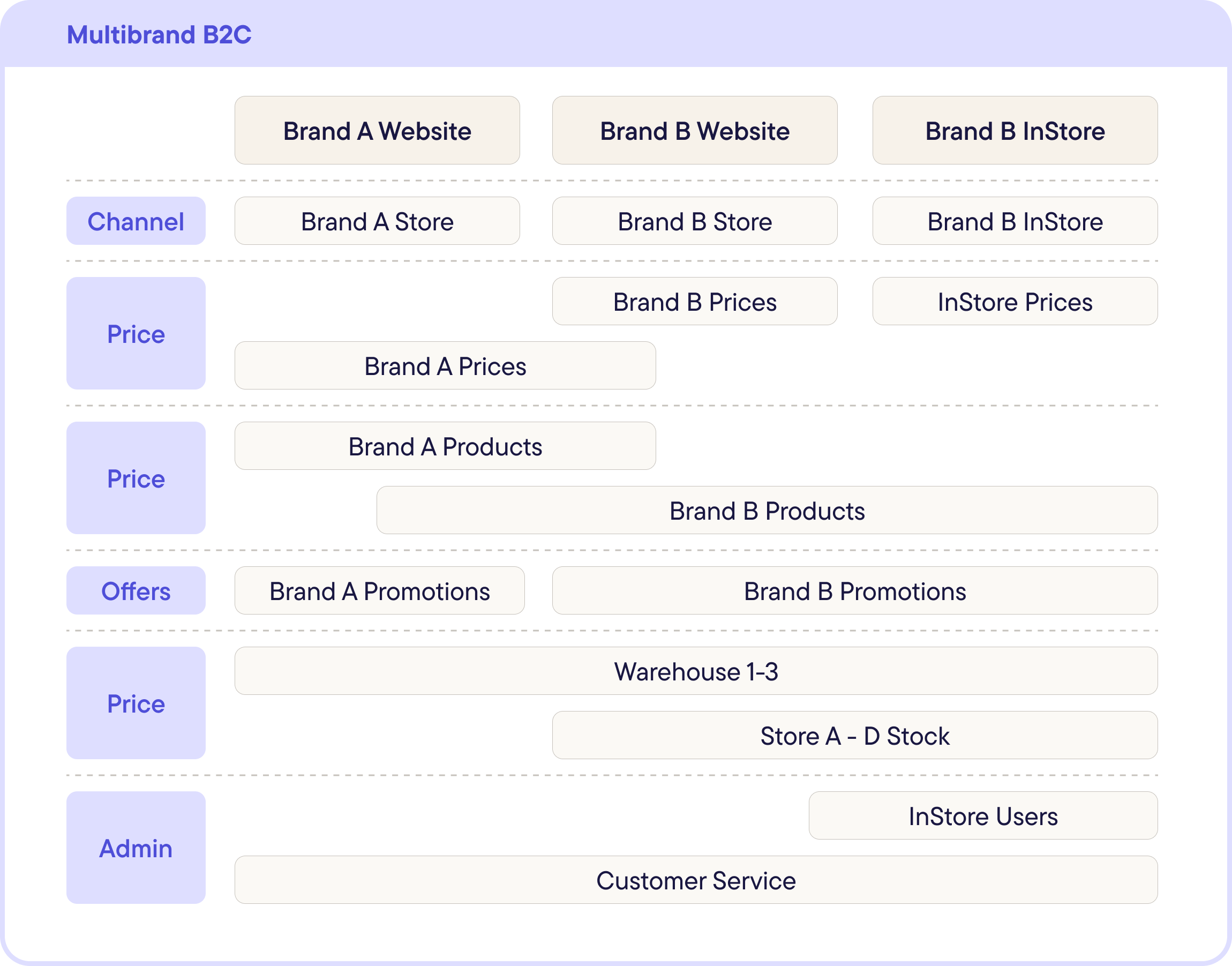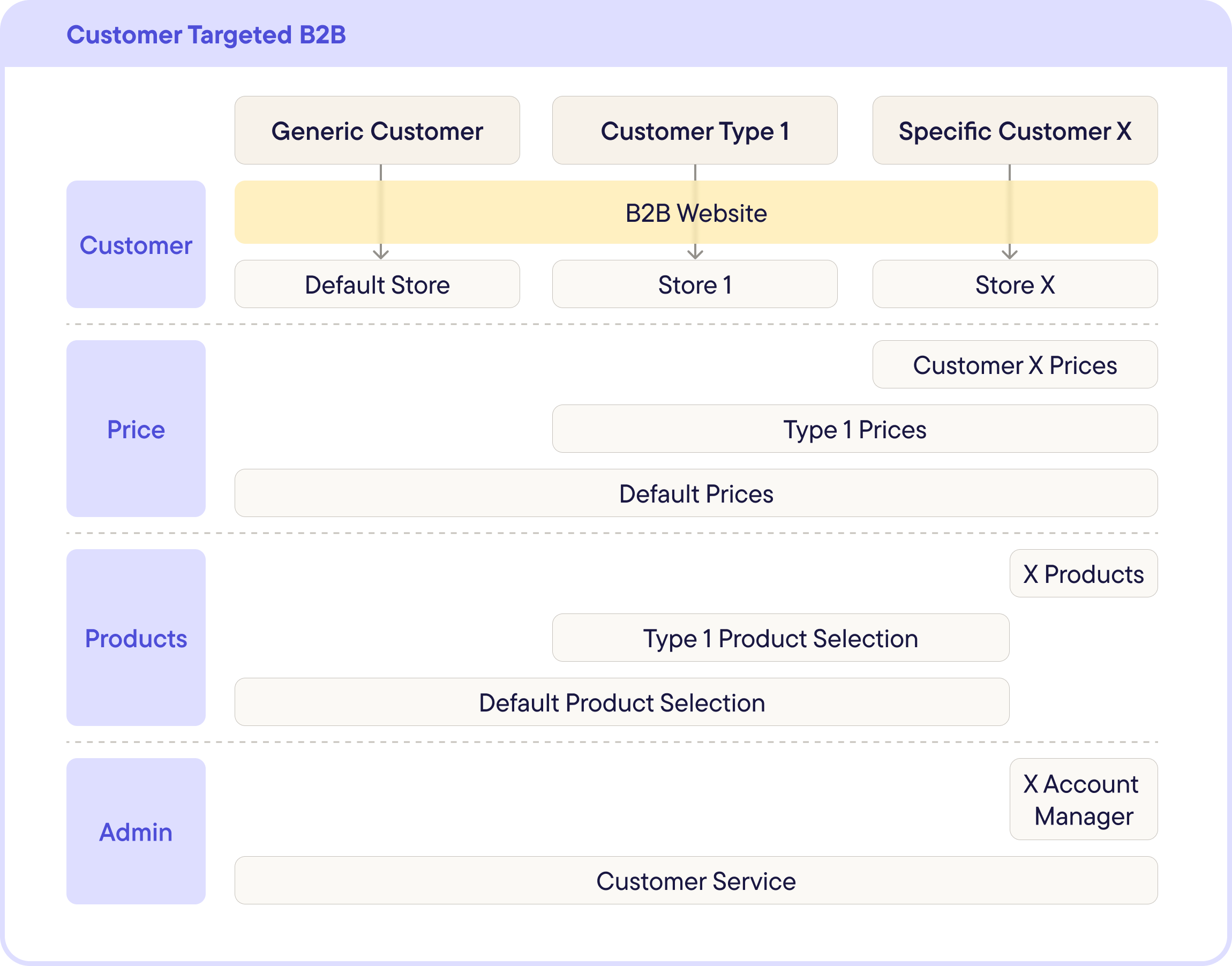
Enterprises are selling their products and services across multiple countries, channels, brands and business models to power their growth. But technically, making this happen isn’t always easy — often, businesses have to rely on multiple commerce platforms to achieve a level of differentiation that’s needed for each country, channel or business. And, in the age of unified commerce, that’s a no-no.
So, what if enterprises could unify commerce while differentiating how they sell to each customer segment without duplicating data structures? That’s what Stores, a commercetools feature, is about.

Today’s complexity in commerce needs a flexible solution
In a simple commerce scenario, all you need is one set of products, one price and one storefront for all customers. For most businesses, however, the reality is far more complex. They often sell across multiple channels (online, in-store, telesales, agentic, etc.) and locations (both internationally and geographically in each country). Many operate multiple brands with intersecting product sets, different prices and currencies, and even subtly tailored descriptions depending on who the customer is, what site they’re on and where they’re located. This complexity is even further exacerbated when different business models are introduced (B2C, B2B, B2B2C).
The commerce software industry has generally supported a small subset of this complexity, with prices and languages, but neglected to support the complexity of variation that enterprises need. This leads to platforms with multiple workarounds, generally increasing the complexity of implementation and integration, as well as significantly slowing down business users in managing those solutions.
So, what if enterprises could unify their commerce data while differentiating how they sell without workarounds, preserving efficiency and scale? This is exactly what Stores, a commercetools feature, is designed for.
What is store modeling?
Store modeling is a functional capability that lets enterprises fully realize the benefits of a unified commerce platform. It allows them to maintain centralized master data — customers, products, inventory and pricing — while creating logical groupings tailored to specific contexts, such as:
Channels
Countries
Brands
Retail stores
Customer segments
Business models
This approach allows enterprises to efficiently manage meaningful differentiation without duplicating data. By combining the following shared or unique resources, Stores ensure that each context, whether website, sub-brand, physical store, point of sale or customer, delivers the right experience across:
Price
Inventory / stock
Products (and product attributes)
Promotions
Stores also offer the option of isolating products, promotions, customers and orders to a specific store. This allows an enterprise to offer either a unified customer account across all their stores or separate accounts (brand sites, locations, business models) per store.
From an operational point of view, the enterprises’ colleagues may also have roles and permissions aligned with access to certain resources tied to a specific store, controlling a colleague’s or team’s ability to manage these objects through the commercetools Merchant Center (our business tooling to manage all things commerce):
Customers: Registered customers’ account information.
Business units and associate accounts: A B2B customer’s business unit hierarchy, business information and associated (customer) accounts, including the associate’s roles and permissions.
Orders: The order details, associated payments, shipments, returns and order edits.
Quotes: Requests for quotes from businesses, as well as the draft, offered and accepted quotations.
Product selections: A subset of the full product catalog used to control product visibility to a store.
Cart discounts: The cart-level discounts linked to the store.
Practical store modeling examples
To illustrate how Stores can be applied in real-world settings, let’s explore two practical scenarios.
A multi-brand retailer might have two or more online storefronts and multiple physical stores. The websites may sell overlapping products at different prices, with varying descriptions and running different promotions at any given time. In this scenario, a commercetools store can be configured for each storefront.

Each brand site would have its Product Selection to define the subset of products sold in each brand’s stores and countries. Multiple selections can be combined to create blended catalogs, and exclusion selections can remove products that will not be sold in that store.
Product attributes, such as the description, can also be varied by store using the Product Tailoring feature, so different brands can change attributes to match their brand identity. Each store’s merchandising team can also be given access to only control products in a given Product Selection.
A supply channel can be created for each retail store and warehouse to provide stock visibility to the store. Where relevant, this allows shipping from the store, endless aisles and display of available physical store stock online.
Pricing or distribution channels may also be defined to change the pricing for each brand and retail location. However, these may take the form of a standard ‘Recommended Retail Price’ style price list with an overriding price list, where items are cheaper or more expensive in specific stores, minimizing the maintenance of these lists.
Finally, promotions can be targeted either across the enterprise (for example, if a supplier initiates the promotion) or in a specific store.
A global manufacturer supplies industrial spare parts to distributors, field service operators and OEMs. They may also operate in multiple countries with localized partners. The type and range of spare parts sold to distributors, field services operators and local partners differ across these businesses. Products may even be co-created or exclusively supplied to one customer or organization. They might offer different prices where the products sold might be the same, custom contracts, tiered pricing and inventory specific to different regions.
In this scenario, a store can be set up for each of the customer segments, organizations or specific customers as required, allowing tailored catalogs to be presented to an organization, business unit or even individual associate buyers.

Multiple price lists may also be created, starting with a generic “standard” price list as the generic starting point. In a simpler scenario, several tiers of discounted pricing may be applied to some or all of the products, and customers’ stores moved between these price lists as they increase or decrease their volumes. In the common scenario where categories, products or ranges are negotiated to a specific value, these new prices may also be applied to a specific customer, while still falling back to standard or discounted prices where products have not been specifically priced.
For a business, admin or sales users can be given store-specific roles, allowing them to work on their business customers’ quotation requests, orders and account admin, while viewing or editing other customers of the organization.
What are the benefits of store modeling?
While the options presented in this article can seem rather complex, with many different permutations and options, the reality is that many will not initially apply. The complexity handled by commercetools’ Stores allows an enterprise to accurately model its current structure, while allowing new routes to market, channels or brands to be added later with ease. This also enables businesses to pilot as quickly as possible: A new market with a subset of products or customers can be launched with a new store.
Stores and the store model allow for maintaining a single catalog, price list, customer list and set of promotions across all transactional touchpoints, creating a truly unified commerce platform. These can then be overridden or added to as required to create unique, targeted and contextual experiences for every touchpoint your enterprise needs.
By concentrating on maintaining a core set of resources, you don’t waste time trying to keep multiple versions of your catalog in sync, troubleshooting or replicating effort around many subtly different catalogs or price lists.
As an API-first platform, with a store argument supported in all relevant requests, commercetools makes accessing the correct experience for each customer as simple as possible. Regardless of how your customers interact with your brand, whether it’s web, mobile, in-store, through telesales or even agentic commerce, the customer’s store experience is instantly tailored to match, providing the right price, products and availability to them, without any extra effort from your developers.
Stores allow you to separate product, customer, and order data administration and assign it to the relevant teams in your business. This allows customer service, marketing and telesales organizations to manage their part of the business without interfering with others. This leads to clearer responsibilities across teams and reduced errors while maintaining a single source and consistency.
Backoffice workflows, such as refund processes and order management, could also be scoped to the stores feature. As your business scales, you can automate where necessary and avoid duplication of efforts, while enabling your teams to be independent but always aligned.
In summary
As enterprises continue to adopt a truly unified commerce experience, transacting in:
Multiple countries,
Physical retail environments,
Through multiple business models (B2B, B2C, B2B2X),
And on different channels (web, mobile, pos, device, agentic, telesales)
The commercetools store model gives them the flexibility to deliver tailored, relevant experiences while maintaining a shared core commerce engine. It helps keep complexity low, teams aligned and costs under control.
The result? Focused teams, increased speed to innovation and a strong commerce foundation built for whatever comes next.
Try out the commercetools stores feature and read more about best practices for store modeling in our guidelines.
